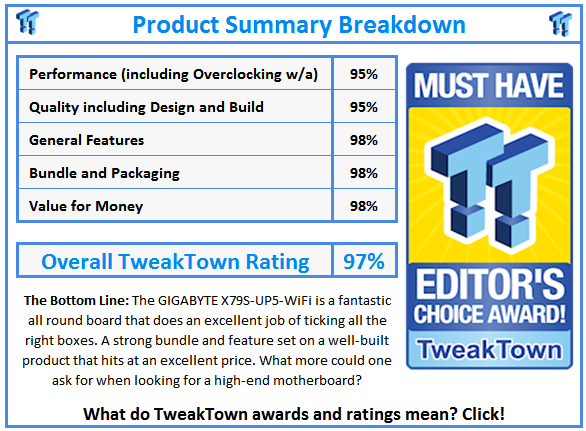Introduction and Package
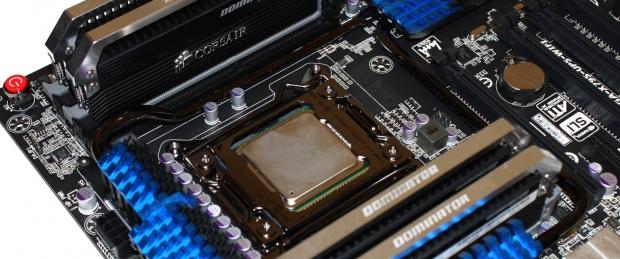
With Intel not doing a lot with the CPU and motherboard market till the middle of the year when Computex hits, we're seeing companies hit us up with some refreshes of popular established chipsets. Recently we have not only received a bunch of Z77 motherboards, but we've also seen a couple of X79 ones show up to continue to keep Intel and its partners in the spotlight.
Outside of these Intel boards recently, though, we've got a couple of AMD boards lined up waiting for the recently looked at AMD A10-5800K and FX-8350 processors to be installed in to. Today, though, isn't about AMD based chips or boards, instead we're all Intel here. The X79 Express chipset really should need no introductions, it's been the chipset of choice in our video card testbed since launch thanks to the power house of CPU's that fit in it including the beloved Extreme Edition series. We're not exactly dealing with the Intel X79 chipset today, though. Instead we've got the Intel C606 chipset on offer which is actually the server version of the high-end X79 chipset. It brings with it a few extra options which we'll cover as we work our way through the motherboard.
Along with support for some of the fastest CPU's on the planet, the chipset also carries support for massive amounts of RAM and video cards. While it's been almost a year since we looked at an X79 motherboard, we dust off our trusty 3960X that has been sitting around and find out just what this chipset has to offer.
Today we're looking at a board from GIGABYTE with the X79S-UP5-WiFi name attached to it. The UD5 / UP5 name has always been one that has impressed us with a strong feature set and a more aggressive price point than its bigger brothers.
There are a few things we need to do before we get into the performance side of things. We'll check out the box and the package to see what GIGABYTE is doing in this area. Once we've done that we'll move onto a closer look at the board before heading into the BIOS. Finally before we get into the testing side we'll check out our testbed here today and look at how we went with the overclocking side of things.
Package
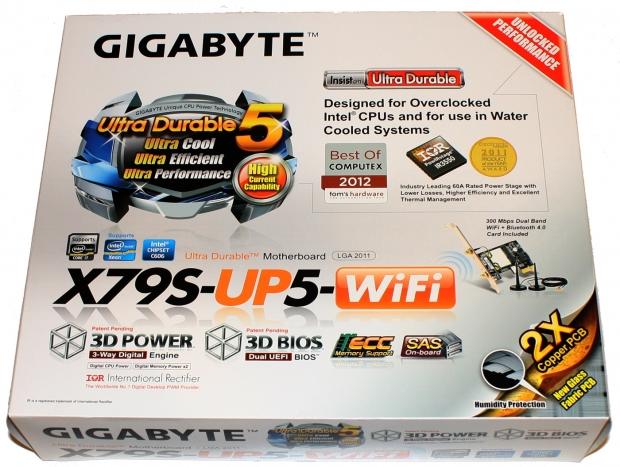
While we're dealing with quite a large box, we're haven't got one that opens up like we see on some of the high-end GIGABYTE offerings. With that said you can see we've got an absolute wealth of information here. Across the top we've got a large push on the Ultra Durable 5 feature while across the bottom you can see the 3D Power and 3D BIOS is being pushed.
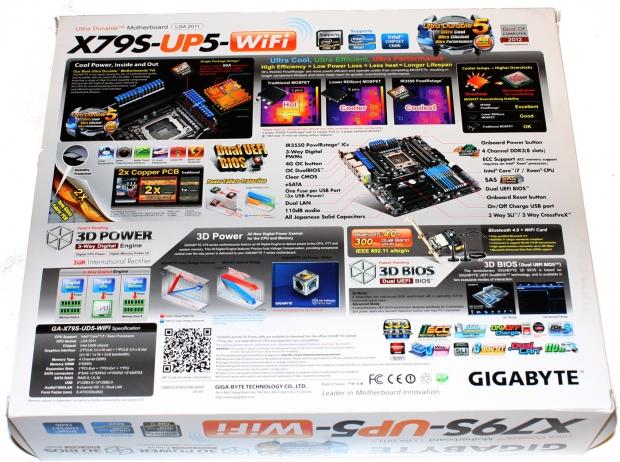
Looking at the back of the box you can see a lot more detail when it comes to the main features that are being pushed on the front of the box. Across the top you can see an expansion of the Ultra Durable 5 side of things and how it offers more power efficiency and better cooling throughout the motherboard. Covered below that is the 2x Copper PCB, Dual UEFI BIOS and look at some of the main features of the motherboard via a picture.
Across the bottom we've got the 3D Power 3-Way Digital Engine, mention of the included Wi-Fi + Bluetooth 4.0 card that's included along with a look at the 3D BIOS that GIGABYTE has been using for a while.
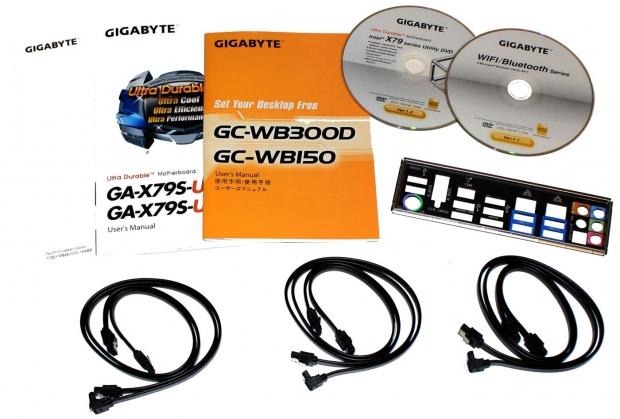
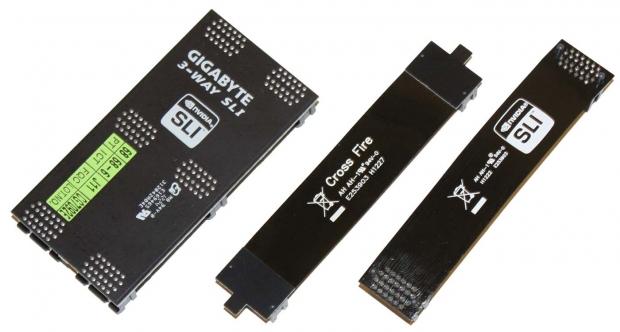
Moving inside the package we've got a lot of the usual suspects here. We've got a bunch of paperwork and a couple of CD's including the standard driver one along with another one for the WiFi / Bluetooth card. We've also got six SATA cables included along with a 3-way SLI connector, standard 2-way SLI connector and a CrossFire bridge.

One of the bigger standouts for the bundle is the combo WiFi / Bluetooth card along with its two antennas. It supports Wi-Fi 802.11 a/b/g/n on the wireless front. When it comes to Bluetooth we've got support for 4.0, 3.0+HS, 2.1+EDR making for quite a versatile card.
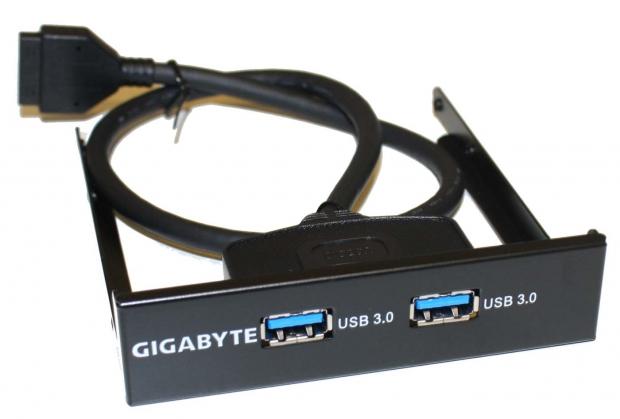
Finally to round the bundle off we've got a front panel dual port USB adapter included.
GIGABYTE X79S-UP5-WiFi Motherboard
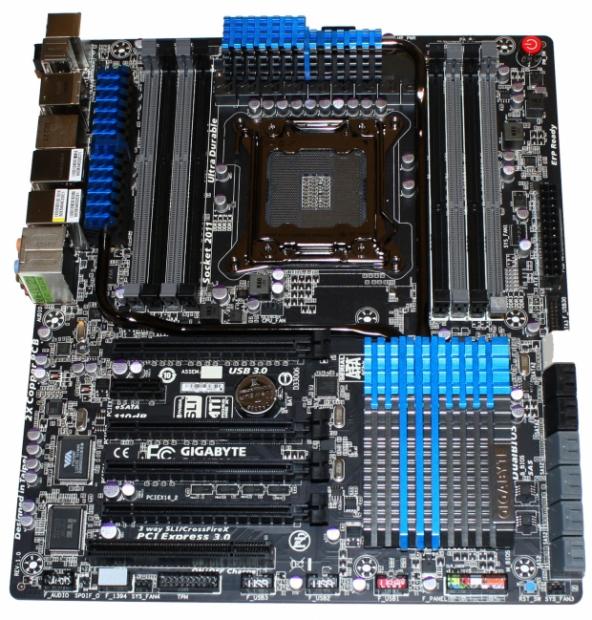
Moving away from the box and bundle we start to look at the motherboard which you can see above follows that typical UD5 / UP5 black and blue color scheme that we really love. You can see a strong heatsink setup being a high-end board.

Looking above you can see we've got a single PCIe x1 slot and an older legacy PCI slot. Along with those two we've also got four PCIe x16 slots that run in an x16 / x8 / x4 / x16 configuration supporting both 3-way SLI and CrossFireX.

Heading across the bottom we can see the normal line up of headers including a front audio, 1394 Firewire, TPM, three USB 2.0 ports and front panel header. There is also a pair of fan headers and a reset switch situated in the bottom right hand corner.
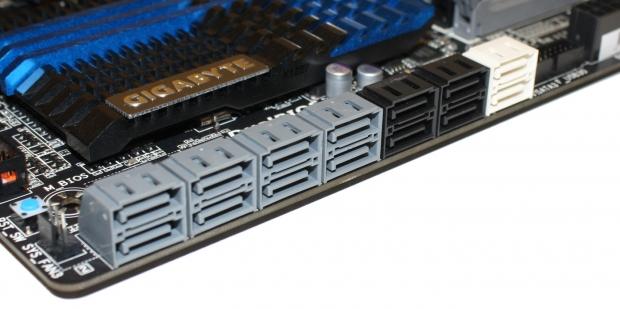
Turning the corner you can see a massive line up of SATA ports with a grand total of 14 being seen. Towards the top we've got two SATA III in white and four SATA II in black running off the Intel chipset. Across the bottom we've got a total of eight SAS ports running off the Intel C606 controller which gives us support for RAID 0, RAID 1, RAID 5 and RAID 10. The addition of the SAS ports is one of the main added features that is brought to the C606 chipset over the standard X79 chipset.
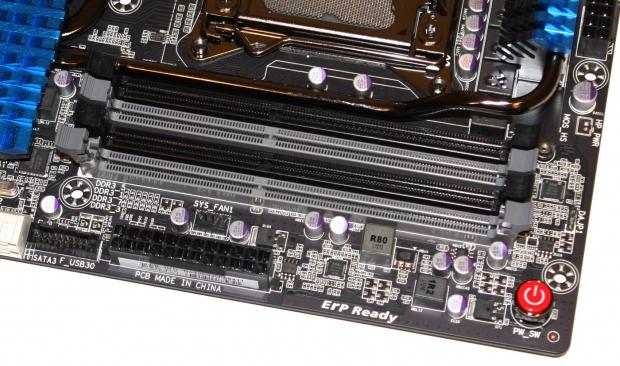
Heading towards the top of the board you can see four of the eight total RAM slots that are present on the board. We've got support for up to 64GB of DDR3 ranging from 1066MHz to 2133MHz DDR. Towards the bottom left hand side you can see a front panel USB 3.0 header while next to that we have the main 24-pin ATX power connector. And finally over to the far right corner you can see a power button present.
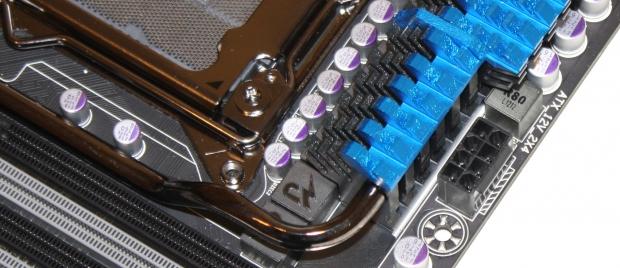
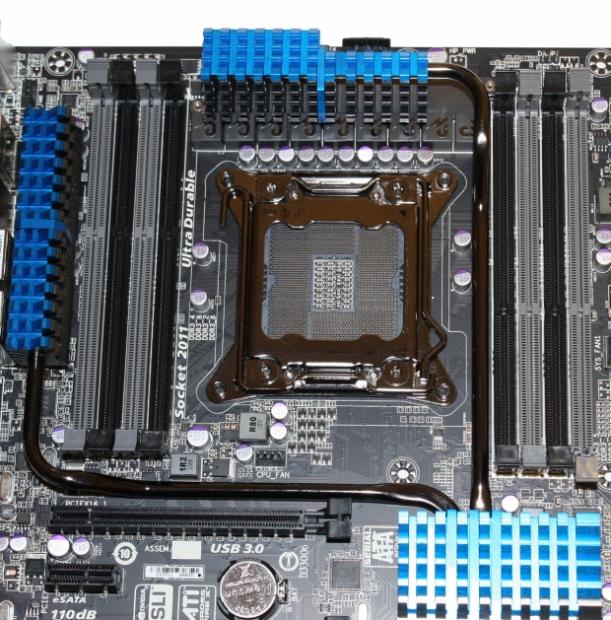
As we move further back you can see the 8-pin CPU power connector sitting across the top of the board behind one of the heatsinks. You can also see the other four DIMM on the left hand side of the motherboard. The CPU area itself is fairly clean with little being seen around it.

We've got the typical PS/2 combo port along with a total of five USB 2.0 connectors. We've got an OC switch that's present which we'll cover in the overclocking side of things while below that we've got a button that lets us switch between BIOS 1 and BIOS 2. And below that we've got a small little black button that resets the BIOS if anything goes wrong.
Continuing to move across we've got a 1394a Firewire port running off the VIA VT6308 chip. We've a combo USB / eSATA port along with an eSATA III port that runs off the Marvell 88SE9172 chip. Four USB 3.0 ports are present that run off the VIA VL800 chip and above them we've got two Gigabit networking ports. One runs of the Intel chip while the other uses the Realtek one. Finally we finish off with five auxiliary audio ports and an optical out that run off the ALC898.
While normally we'd head straight into the BIOS, we want to cover the C606 chipset a little closer since this is the first time we've used a board that makes use of it. As we mentioned just earlier, this is a server version of the X79 chipset, and as such offers a few extras, which can be seen below.

Max TDP is slightly higher along with a slightly different PCIe configuration being available. The other few main differences refer to some of the Intel technologies that are more focused on the server side of things - Intel Trusted Execution Technology, vPro Technology and Active Management Technology.
BIOS
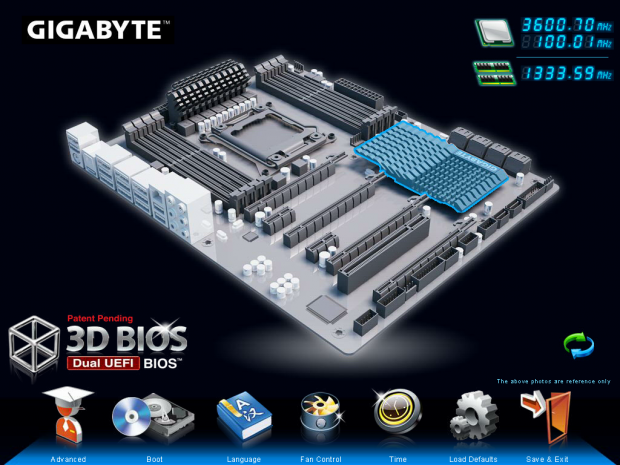
Heading into the BIOS area you're really not going to see anything that you aren't too familiar with even though we're dealing with a server chipset here.
After updating to the latest BIOS we're greeted by the 3D BIOS when we first get in. As we've mentioned before, we've never been a huge fan of this, as it tends to make the whole process of working around the BIOS a little slower. As always, though, we're not forced to use it and we head straight to the advanced section.
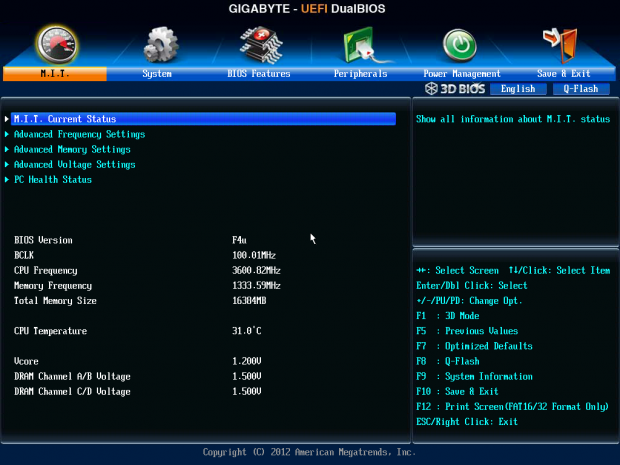

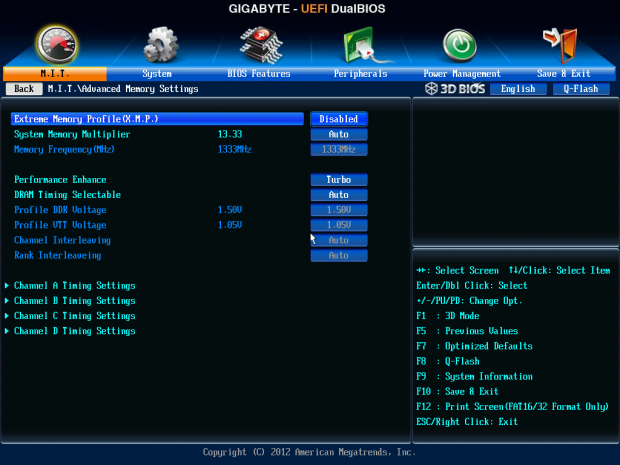
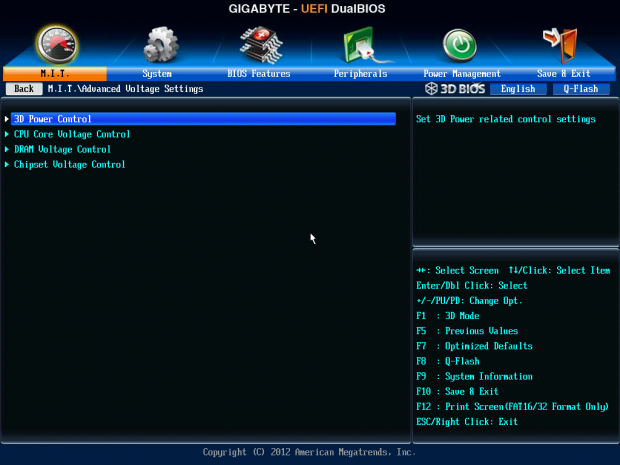
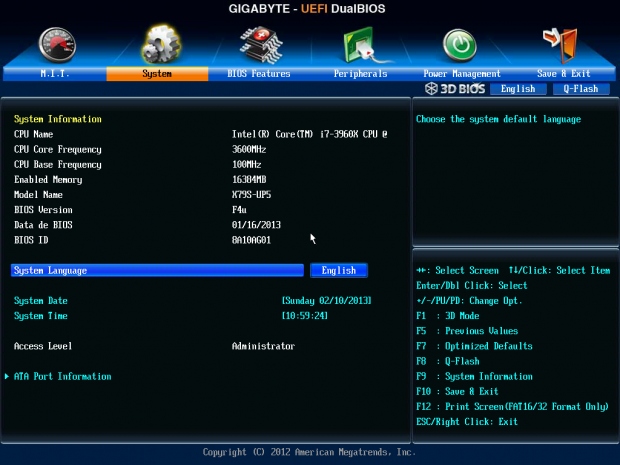

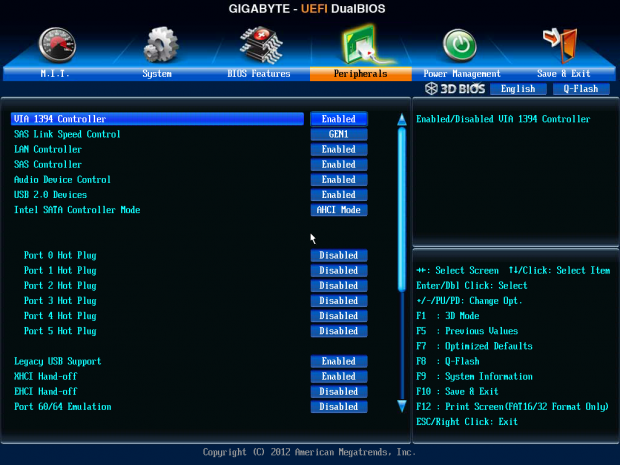
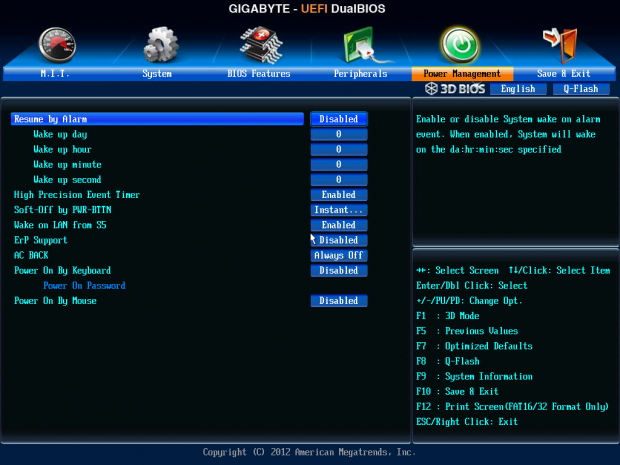
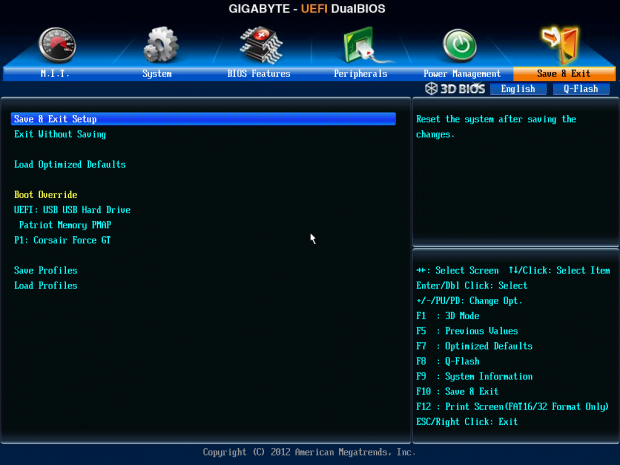
If you've used a GIGABYTE UEFI BIOS since they introduced it you're going to know exactly what you're dealing with here. When it comes to the overclocking side of things you're going to want to be in the M.I.T. area of the BIOS which is the first screen in the advanced area. Here you've got all your normal abilities like adjusting frequencies, multiplier, RAM speeds and voltages to name just a few things.
Outside the M.I.T. area you've got the normal options available that give the ability to enable and disable certain features and technologies. We've got the ability to save profiles and in the bottom right corner you can see a list of short cuts to get around the BIOS including F8 to open up Q-Flash and update to the latest BIOS version via a USB drive.
Benchmarks - Test System Setup and Overclocking
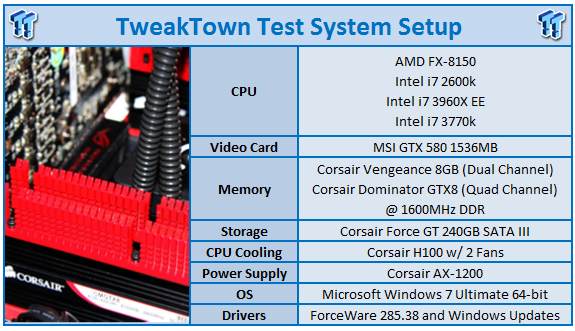
We would like to thank the following companies for supplying and supporting us with our test system hardware and equipment: Intel, ASUS, MSI, Western Digital, MemoRight and Corsair.
Along with this GIGABYTE offering running at both stock and overclocked speeds, we've also got the ASRock X79 Extreme4 present. Along with those two boards we've got a bunch of Z77 boards that we've looked at recently using the Intel Core i7 3770k. These boards include the ASRock Z77 OC Formula, GIGABYTE Z77X-UD4H and finally the ASUS Maximus V GENE to round off the collection.
Before we get into the performance side of things we will cover the overclocking department. As usual we jump straight into the BIOS and head to the M.I.T. area. From here we're able to start to adjust our voltages, BCLK and CPU multiplier.
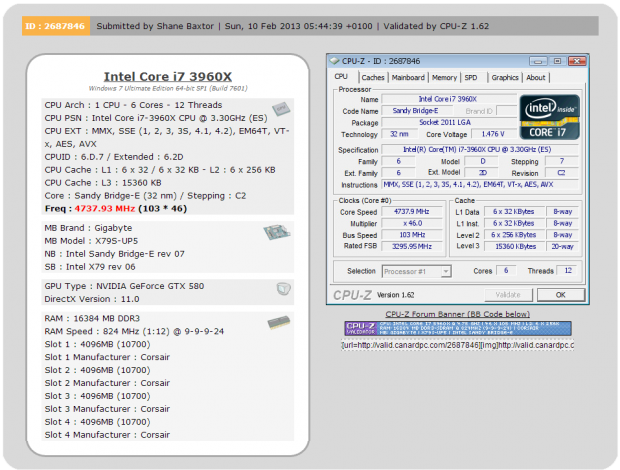
After going back and forth waiting to find which setting that was 100% stable, we ended up with the CPU multiplier at 46x and the BCLK slightly raised to 103. As you can see above, this resulted in a final clock speed of 4738MHz or 4.74GHz, as shown in our graphs here today.
Before we get into the performance side of things we want to quickly cover the "OC" button that we mentioned earlier which is located on the I/O panel. Pushing this button before the machine is powered up causes the machine to power up, then reboot after a short period.
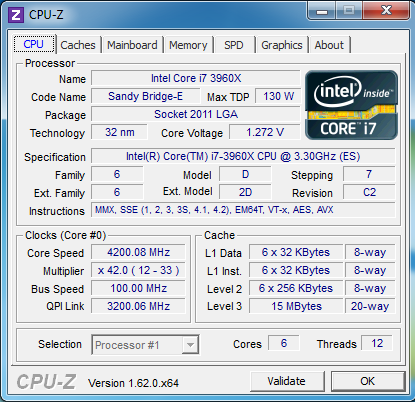
With everything finally booted we got into Windows, and as you can see above, we got a slight overclock to 4.2GHz with the need to do nothing more than push a button. This is 300MHz up on the stock 3.9GHz that can be achieved via Turbo on the 3960X.
CPU Benchmarks
HyperPi 0.99
Version and / or Patch Used: 0.99
Developer Homepage: www.virgilioborges.com.br
Product Homepage: www.virgilioborges.com.br
HyperPi is a front end for SuperPi that allows for multiple concurrent instances of SuperPi to be run on each core recognized by the system. It is very dependent on CPU to memory to HDD speed. The faster these components, the faster it is able to figure out the number Pi to the selected length.
For our testing we use the 32M run. This means that each of the four physical and four logical cores for the i7 and the four physical cores of the i5 is trying to calculate the number Pi out to 32 million decimal places. Each "run" is a comparative to ensure accuracy and any stability or performance issues in the loop mentioned above will cause errors in calculation.
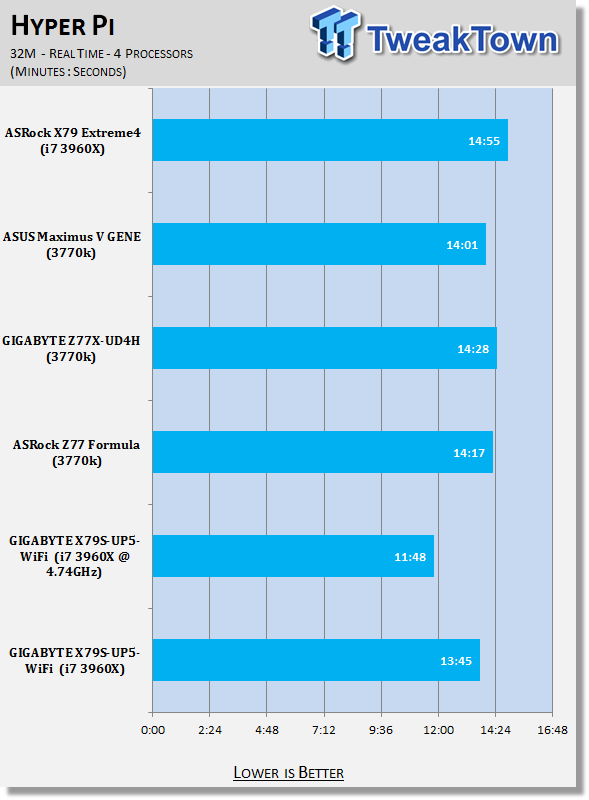
AIDA64
Version and / or Patch Used: 1.00.1035BETA
Developer Homepage: http://www.aida64.com
Product Homepage: http://www.AIDA64.com
Replacing Everest in our labs is AIDA64. This new testing suite is from the core development team from Lavalys and continues that tradition. The guys have thrown in better support for multithreaded CPUs as well as full 64 bit support. We use this to test memory and HDDs for now, but may find ourselves opening this up to other areas of the motherboard.
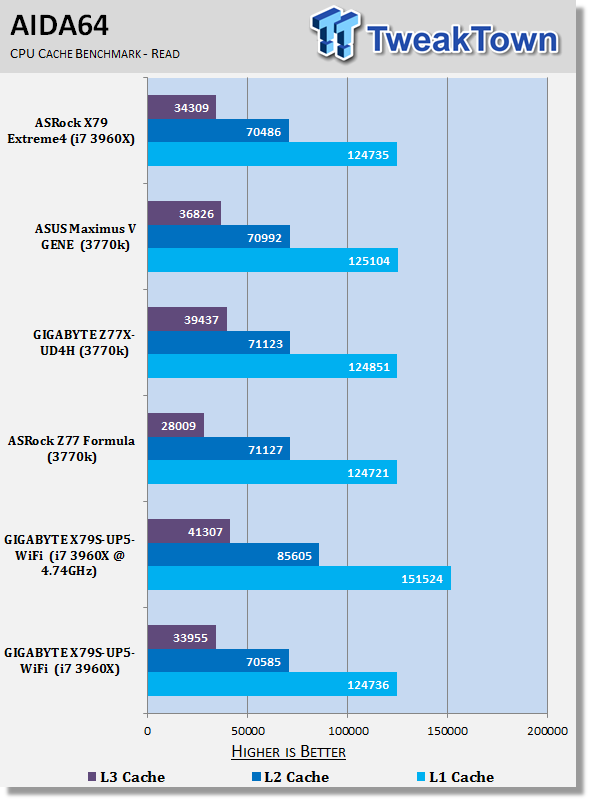
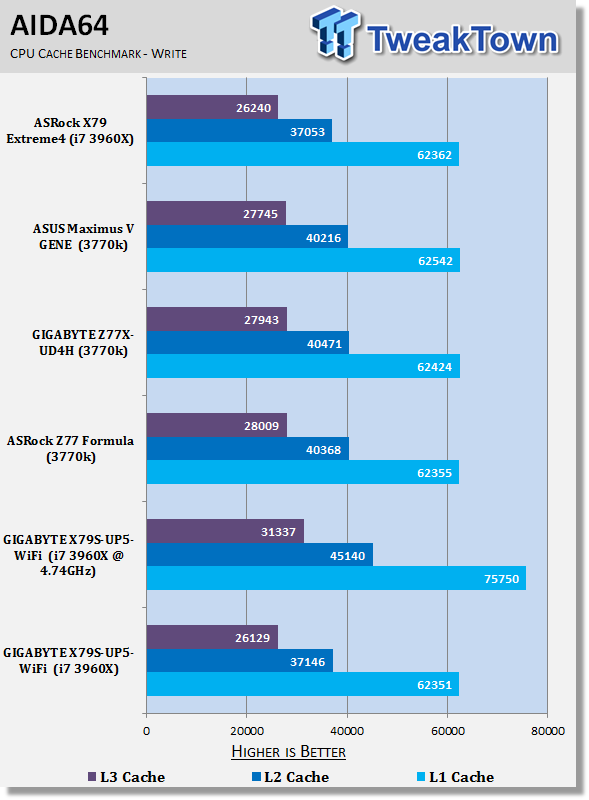
Out of the box you can see that our 3960X manages to put out some strong numbers coming out ahead of the Z77 options, just as you'd hope. As you'd expect, though, when it comes to the overclocking side of things, we see some really nice gains across the board.
We can see under HyperPi a decent amount of time is shaved off the 32M process.
System Benchmarks
PCMark 7
Version and / or Patch Used: 1.04
Developer Homepage: http://www.pcmark.com
Product Homepage: http://www.pcmark.com
PCMark 7 includes a range of tests that give different views of your system's performance. In the Advanced Edition you can choose which tests to run. The common use and hardware component tests are unavailable in the Basic Edition.
Overall system performance is measured by the PCMark test. This is the only test that returns an official PCMark score. The Lightweight test measures the system capabilities of entry-level systems and mobility platforms unable to run the PCMark test, but it does not generate a PCMark score. Common use performance is measured by the scenario tests - Entertainment, Creativity and Production - each of which results in a scenario score. Hardware component performance is measured by the hardware tests - Computation and Storage - each of which results in a hardware score.
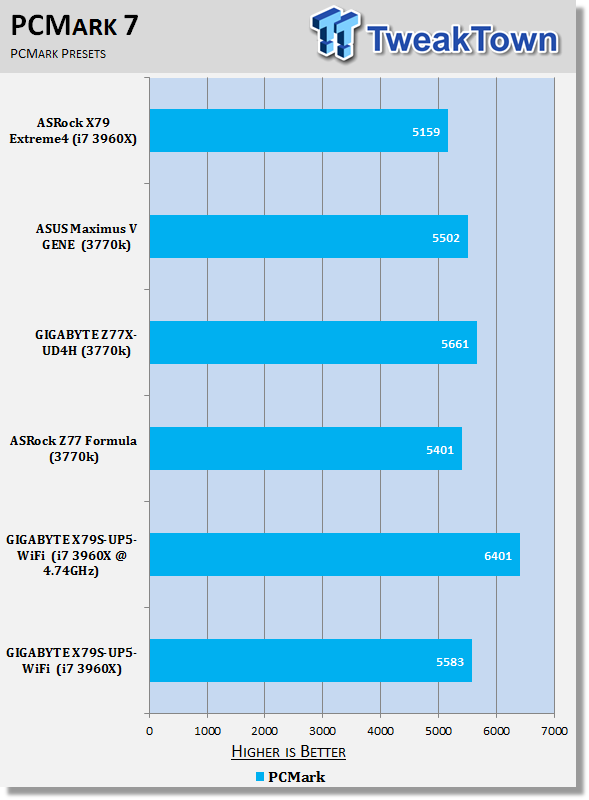
MediaEspresso
Version and / or Patch Used: 6.5
Developer Homepage: http://www.cyberlink.com/
Product Homepage: http://www.cyberlink.com/products/mediaespresso/overview_en_AU.html?fileName=overview&r=1
MediaEspresso is a blazingly fast media universal converter that can transcode your videos, photos and music files and out put them to a huge range of portable devices including mobile phones, portable media players and even game consoles. With technologies like Smart Detect, Direct Sync and CyberLink's TrueTheater™ video enhancements, you can not only forget about complicated format, resolution and output settings, but your converted file will come out the other side looking better than when it went in!
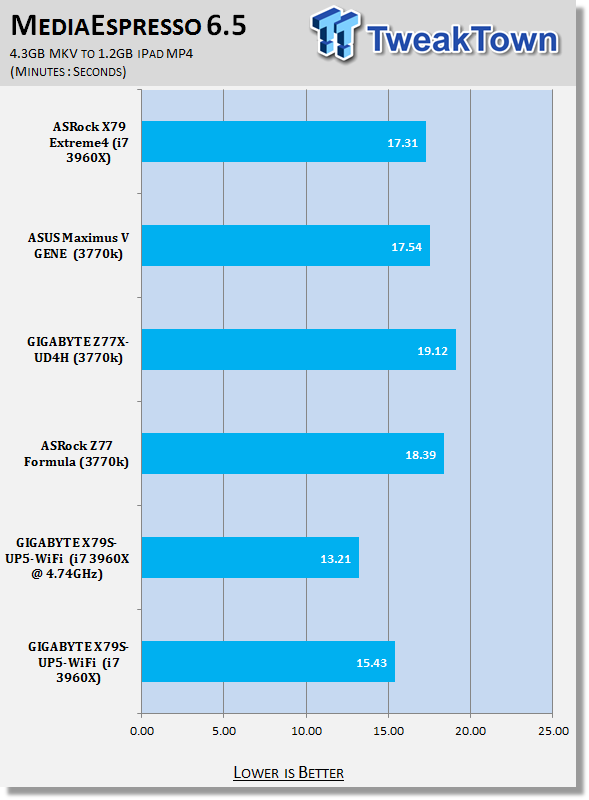
PCMark 7 numbers from the X79 build are similar to our Z77 ones.
You can see a decent increase over the ASRock X79 Extreme4, though. MediaEspresso on the other hand manages to separate itself a bit better out of the box and then goes onto get an even greater lead when overclocking is thrown into the mix.
USB 2.0 and 3.0 Benchmarks
AIDA64
Version and / or Patch Used: 1.70.1400
Developer Homepage: http://www.aida64.com
Product Homepage: http://www.AIDA64.com
Replacing Everest in our labs is AIDA64. This new testing suite is from the core development team from Lavalys and continues that tradition. The guys have thrown in better support for multithreaded CPUs as well as full 64 bit support. We use this to test memory and HDDs for now, but may find ourselves opening this up to other areas of the motherboard.

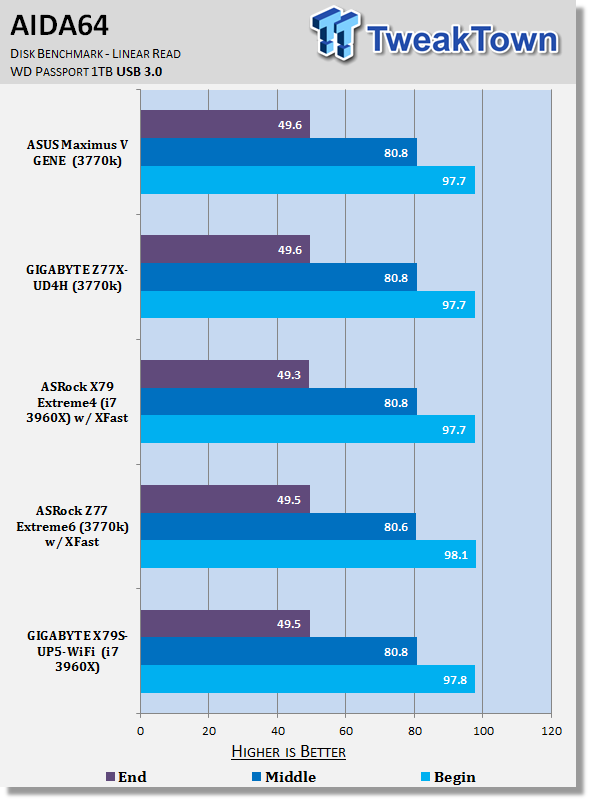
In a fairly typical setup here you can see our USB 2.0 numbers line up as you'd expect with other boards that don't make use of the ASRock XFast technology. Moving into the USB 3.0 numbers you can see all our boards line up very close to each other, also just as you'd expect.
SSD Benchmarks
AIDA64
Version and / or Patch Used: 1.70.1400
Developer Homepage: http://www.aida64.com
Product Homepage: http://www.AIDA64.com
Replacing Everest in our labs is AIDA64. This new testing suite is from the core development team from Lavalys and continues that tradition. The guys have thrown in better support for multithreaded CPUs as well as full 64 bit support. We use this to test memory and HDDs for now, but may find ourselves opening this up to other areas of the motherboard.
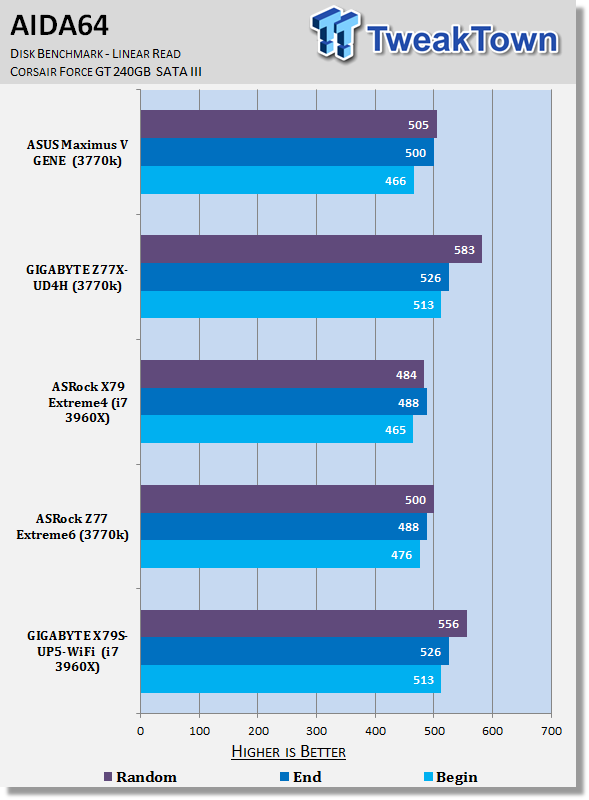
HD Tune Pro
Version and / or Patch Used: 4.61
Developer Homepage: http://www.hdtune.com
Product Homepage: http://www.hdtune.com
HD Tune Pro gives us accurate read, write and access time results and for the last couple of years has been gaining popularity amongst reviewers. It is now considered a must have application for storage device testing.
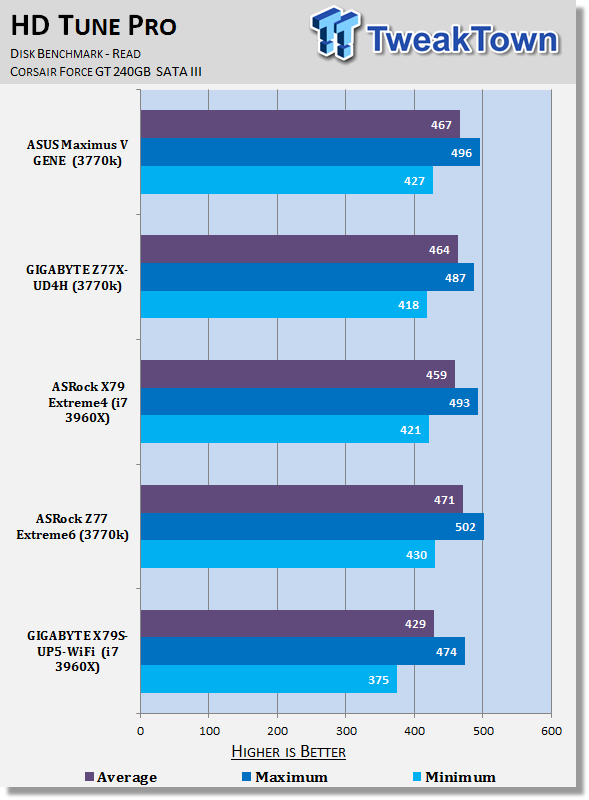
Under AIDA64 you can see some strong performance numbers across the board lining up with the other GIGBAYTE options that we've got here.
Moving into HD Tune Pro, though, you can see the numbers aren't quite as impressive. This is something we've been seeing for a while now. We get really strong numbers under AIDA64, but when we move to HD Tune Pro, though, the numbers while good, aren't as good as they were under AIDA64.
Memory Benchmarks
AIDA64
Version and / or Patch Used: 1.00.1035BETA
Developer Homepage: http://www.aida64.com
Product Homepage: http://www.AIDA64.com
Replacing Everest in our labs is AIDA64. This new testing suite is from the core development team from Lavalys and continues that tradition. The guys have thrown in better support for multithreaded CPUs as well as full 64 bit support. We use this to test memory and HDDs for now, but may find ourselves opening this up to other areas of the motherboard.
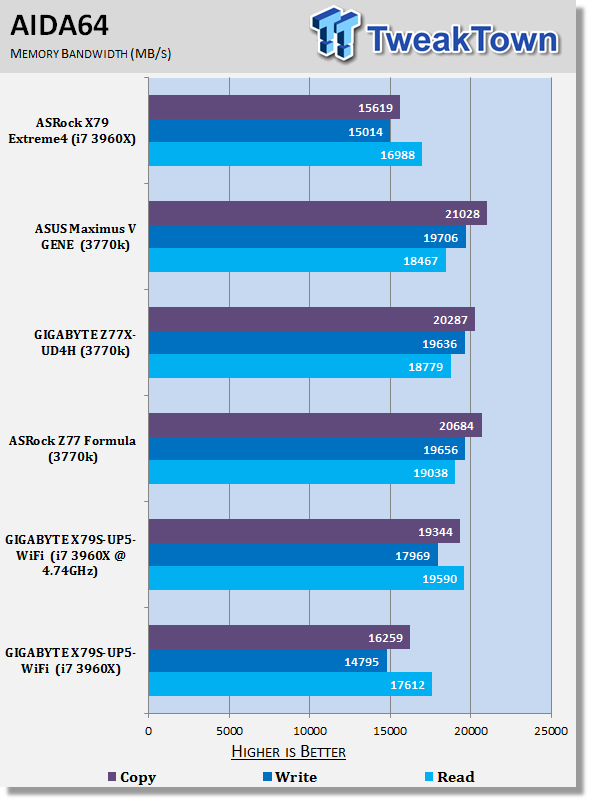
Quad Channel numbers have never been as strong as Dual Channel ones when comparing the Z77 and X79 chipset.
Here is no different. Looking above you can see we see some great gains when overclocked. This is something that the Z77 doesn't tend to do as strongly with numbers remaining quite similar when we overclock.
Gaming Benchmarks
3DMark 11
Version and / or Patch Used: 1.0
Developer Homepage: http://www.futuremark.com
Product Homepage: http://www.3dmark.com/3dmark11/
3DMark 11 is the latest version of the world's most popular benchmark. Designed to measure your PC's gaming performance 3DMark 11 makes extensive use of all the new features in DirectX 11 including tessellation, compute shaders and multi-threading. Trusted by gamers worldwide to give accurate and unbiased results, 3DMark 11 is the best way to consistently and reliably test DirectX 11 under game-like loads.
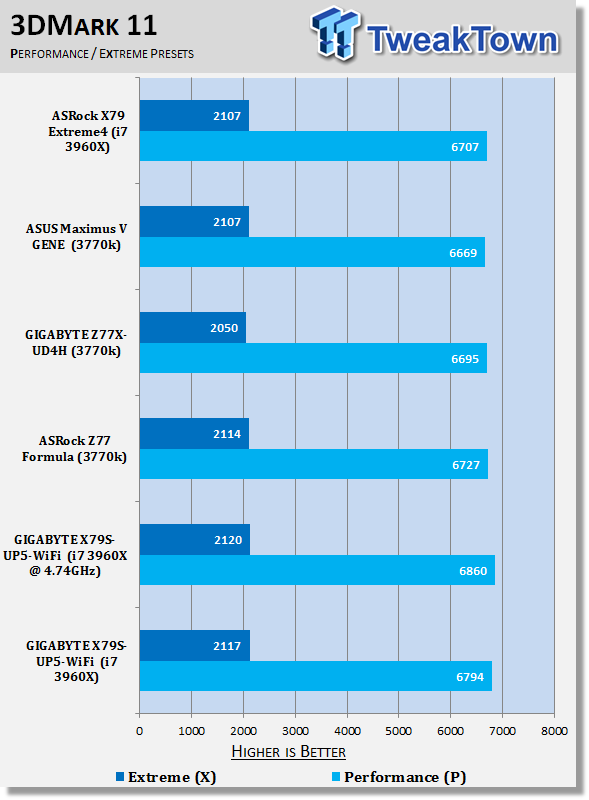
Metro 2033
Version and / or Patch Used: Latest Steam Update
Timedemo or Level Used: Built in Benchmark
Developer Homepage: http://www.4a-games.com//
Product Homepage: http://www.thqnordic.com/
Metro 2033 is an action-oriented video game with a combination of survival horror and first-person shooter elements. The game is based on the novel Metro 2033 by Russian author Dmitry Glukhovsky. It was developed by 4A Games in Ukraine and released in March 2010 for Microsoft Windows and Xbox 360.[3] In March 2006, 4A Games announced a partnership with Glukhovsky to collaborate on the game.[4] The game was announced at the 2009 Games Convention in Leipzig;[5] a first trailer came along with the announcement.[6] A sequel was announced, currently titled Metro: Last Light.
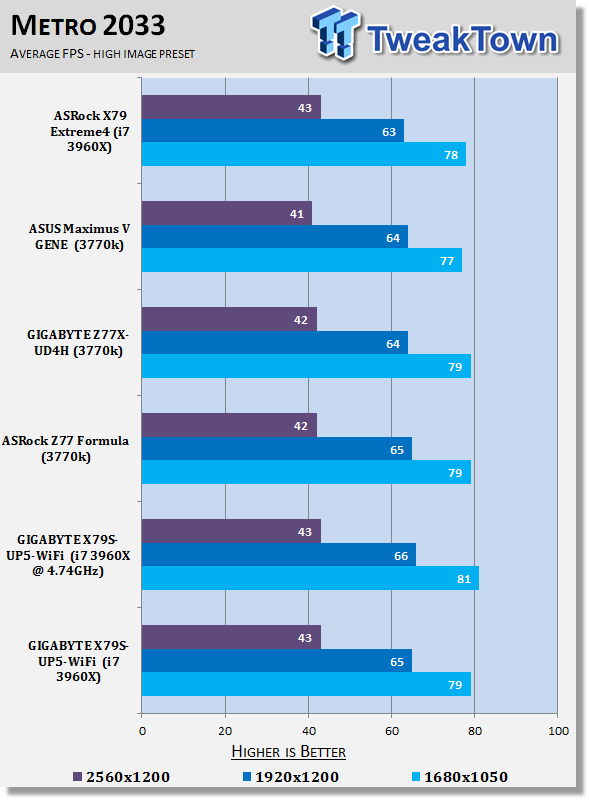
Gaming performance doesn't hold any surprises - the numbers are fairly typical with all our setups performing quite close to each other. Overclocking sees a slight boost in the lower resolution numbers, but not a whole lot to get excited about.
Temperature and Power
Power Consumption
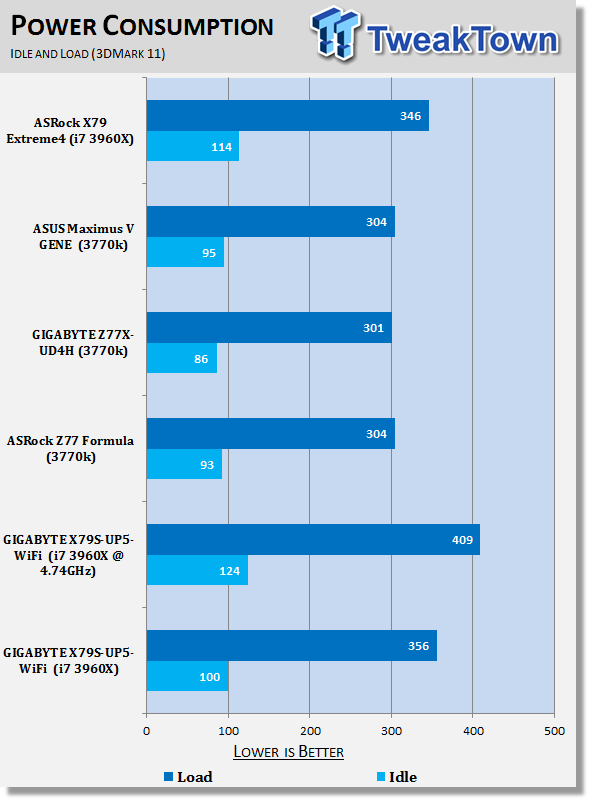
It comes as no surprise to us that power draw is higher on this board compared to the others.
With a strong lineup of features and just generally a higher end CPU you're going to have a system that is drawing more power. At idle, though, the numbers till look good coming in at 100w, with overclocking drawing 24% more than that. Moving to load you can see that compared to the Z77 setups the 3960X draws about 33% more power at load.
Core Temperature
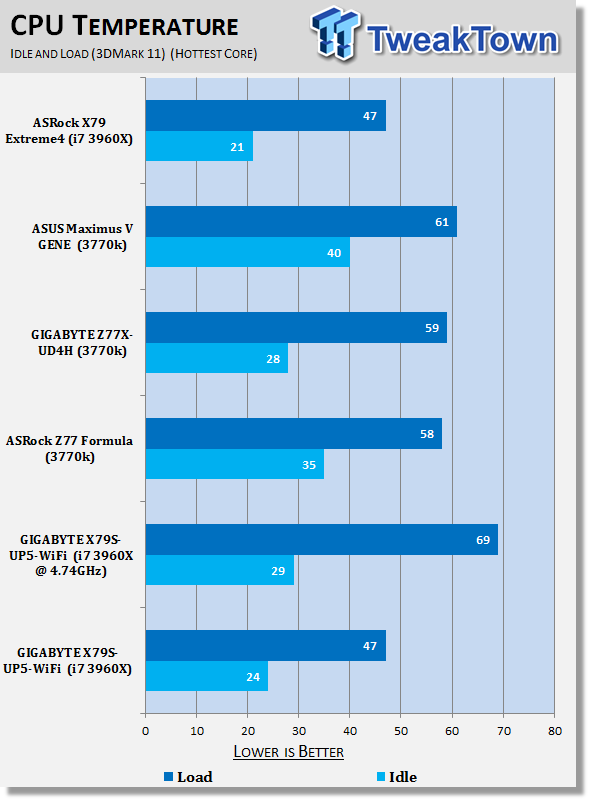
Looking at the temperature of our CPU you can see that the difference between both the GIGABYTE and ASRock X79 offerings are quite small with little separating them. At load you can see a jump in both areas, but overall, we've got pretty strong numbers coming out of this GIGABYTE board.
Pricing, Availability and Final Thoughts
Starting off with the price, it's probably the one area that gave me the biggest surprise. Considering the bundle we've got, the fact it's based on a higher end (server) chipset and just the generally strong feature set, I was expecting something in the $400 range.
Not only is the board listed for $329.99 over at Newegg, the deal is made even sweeter by the fact that currently a $30 rebate is being offered, hence bringing that price down to a pretty amazing $299.99. This is actually a really aggressively priced board that hits at a price point that feels lower than it should be, even if you ignore the current rebate offer.
The performance of the board is strong and lines up ultimately where you'd expect. We don't have the best 3960X CPU on hand at the moment, so overclocking results for you could well be stronger than what we saw here today, but we hit what tends to be the wall for our particular CPU, which is good. We didn't come in under that CPU clock speed wall, so we're pretty happy.
When it comes to the features, we've got a strong line up thanks to the eight SAS ports that are brought to the table via the C606 chipset. Along with that we've got all the usual inclusions like USB 3.0 and dual Gigabit networking to name just a few things. The other big feature, though, comes in the bundle via the included WiFi / Bluetooth card that adds another layer of connectivity to the board.
Overall GIGABYTE has put together a really strong motherboard that's a great option for anyone who is looking at going down the path of an LGA 2011 build. The toughest decision when it comes to buying a new high-end PC at the moment is do you go down the LGA 2011 path with a X79 / C606 based chipset or follow the impressive LGA 1155 based CPU's with an Z77 chipset, which has proven itself extremely well.

